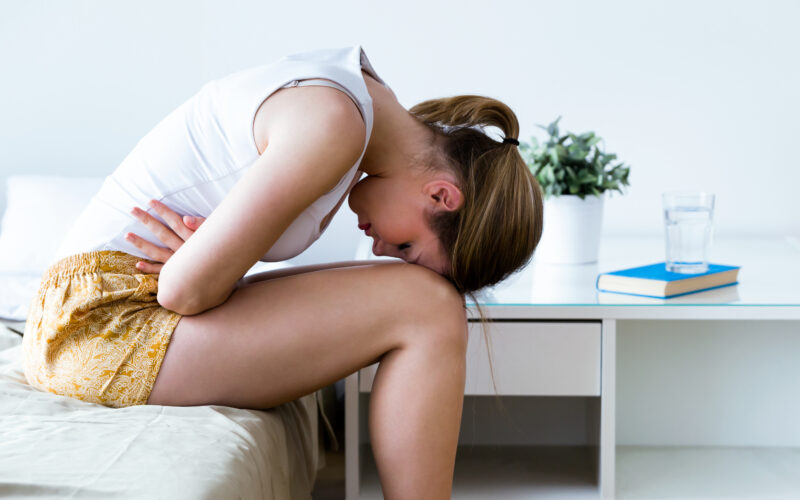Part 2: How to look out for common teen cycle issues
In Part I, we learned about why teen cycles should be understood differently than adult cycles when it comes to “regularity.” We also looked at the number one criterion pediatricians suggest as the indicator for when to see a doctor. In this installment, we want to dive a little deeper into some of the most common teen period problems: specifically, heavy bleeding and pain, which seem to cause the most interference with daily life.
Heavy periods in the teen years: How much bleeding is too much?
We previously discussed how teen cycles can be more irregular than adult cycles as the hypothalamic-pituitary-ovarian (HPO) axis regulates over the course of the first few years of menstruating. We also talked about anovulatory cycles being more common in this stage. Unfortunately, these irregularities can sometimes mean that she goes a long time between bleeds and therefore has heavy periods, or that she has little time between bleeding episodes. Parents are right to wonder about these bleeding patterns. How much bleeding may be too much, especially if anemia (which growing teens are more prone to anyway!) is a concern?
Simply tracking bleeding patterns with a calendar or an app can be a huge help to parents and teens. The total volume of blood lost through anovulatory bleeds or menstruation can range widely, from 5 mL (about 1 teaspoon) lost over the course of a period, all the way up to 80 mL (6 tablespoons) lost [1]. Unless you have a graduated menstrual cup, it can be difficult to measure volume, so perhaps a more helpful guide is the frequency with which your daughter needs to change menstrual products.
A necessary change of pad or tampon more frequently than every 2-3 hours is a clear indicator of excessive bleeding. A typical period bleed will contain a flow of red and brown blood, plus small jelly-like clots; however, clots which are bigger in size than a quarter could indicate an issue [2].
What amount of period pain is “normal” for teen girls?
Unfortunately, teens are more likely to experience heavy and/or painful periods because of the imbalance between estrogen and progesterone that occurs in the first few years [3]. They tend to also exhibit higher sensitivity to prostaglandins, those pesky biocompounds that can cause inflammation, contractions, and pain in the uterus during menses [4].
However, as I stated at the beginning of this article, anything which interferes with your teen daughter’s ability to function is a red flag requiring further exploration by a restorative reproductive medicine provider like a NaPro, NeoFertility, or FEMM-trained doctor or nurse practitioner. This is especially true if pain is not lessening–and especially if it appears to be worsening–as cycles progress. Far too many women were raised with the mentality that periods simply equal excruciating pain, and our only option is to “be a woman” and suck it up!
Getting help for teenage period pain
It’s important during this time to reassure your daughter that these pains will likely ease up as she gets older, but that doesn’t mean that we shouldn’t treat her with the care and attention she deserves.
In general, the best advice I have been given is to be proactive rather than reactive: help your daughter anticipate her period by upping her hydration levels, minimizing inflammatory foods, and honoring her body’s need for a little more rest. Simple diet, exercise, or lifestyle changes can make a huge difference when paired with more familiar pain management like over-the-counter pain relievers or heat. Doctors can be particularly helpful in guiding you towards pain management care for your daughter and her periods.
Should teen girls take hormonal contraception for period problems?
With pain and cycle irregularity to contend with, many concerned parents of teens wonder if hormonal contraception is necessary or the best option for their daughters’ period problems. Yes, many contraceptive options will decrease certain symptoms. For example, there is limited evidence that HCs can help with pain related to prostaglandins; however, we should be quick to point out that hormonal contraceptives don’t actually “regulate” our cycles. Instead, they use synthetic hormones to override our body’s natural ebb and flow of hormones which are produced within a cycle, which can have negative implications for her overall health [5],[6].
Furthermore, the bleeds which girls (and women) experience while taking hormonal contraceptives are not actually period bleeds: they are a medically-induced form of anovulatory bleed, specifically a hormonal withdrawal bleed. Because hormonal contraceptives essentially mask our body’s ability to communicate about underlying cycle issues–and can therefore prevent early detection and treatment of those issues–the choice to use birth control in the teen years should not be taken lightly [7]. We know birth control functions as a Band-Aid rather than a curative treatment, because symptoms of underlying cycle issues will likely return as soon as contraceptive use is halted [8].
What’s more, hormonal birth control can create new problems for teen girls in particular. Teen girls who start hormonal birth control are at risk for new onset depression and suicidal ideation (and for developing depression as an adult), blood clots, bone fractures (even as they should be building towards their maximum bone density years in their early to mid 20s), and strokes. Hormonal birth control further robs teen girls of the beneficial impacts of ovulation on their bone, brain, heart, and immune health (summarized succinctly in this short video). It’s therefore very important to understand and weigh the risks of hormonal birth control use, especially for developing teen girls.
The 3 key steps parents can take to help their teen daughters with period problems
Now, to quickly summarize my advice for parents who are helping their daughters navigate “irregular” cycles:
- Remember that teen cycles in the first few years may just be “irregular!” That is an expected, healthy occurrence.
- Sign your daughter up to learn cycle charting from an instructor certified in a fertility awareness method. Bonus points if you take the course with her so that you’re both getting the same information–especially if it’s new information to you, too! (Note: While “period tracker” apps abound, learning an actual method of fertility awareness provides much more detailed insight into what’s going on in an individual girl’s body, and gives her far more data to provide to her doctor than simply tracking days between periods.) If a full course is too expensive or seems like overkill, consider Pearl & Thistle’s Charting for Girl’s handbook.
- Ask a trusted doctor whenever symptoms seem to be outside normal variance, or whenever they interfere with your daughter’s ability to function. Pay attention to whether your doctor seems interested in investigating the cause of symptoms, rather than immediately masking them with hormonal birth control. In the absence of a pediatrician who seems willing or able to investigate cycle issues, look for a provider who takes a restorative reproductive medicine approach.
Parents: Love your daughters, and do your best
Finally, don’t forget to be gracious with yourself on this journey! Seeing our children struggle or suffer is the most difficult part of being a parent, and moms especially may wonder if their daughters’ troubles are somehow their fault. If you are making an effort to listen and be attentive to her needs, she is learning that her voice matters, that she can trust the signals her body is sending, and that she can trust you to be her advocate. Even if the road to diagnosis, treatment, or just growing out of irregularity is a bit bumpy, your care is an incredible gift to her.
Looking for Part I? Find it here!
References
[1] Ian S. Fraser, H.O.D. Critchley, M.G. Munro, M. Broder, Can we achieve international agreement on terminologies and definitions used to describe abnormalities of menstrual bleeding?, Human Reproduction, Volume 22, Issue 3, March 2007, Pages 635–643, https://doi.org/10.1093/humrep/del478 [2] James AH. Heavy menstrual bleeding: work-up and management. Hematology Am Soc Hematol Educ Program. 2016;2016(1):236-242. doi:10.1182/asheducation-2016.1.236 [3] Briden, Lara. “Chapter 9- Easy Flow: No More Pain and Suffering.” Period Repair Manual. Greenpeak Publishing, second edition: 224-259. [4] Downie, J., Poyser, N. L., Wunderlich, M., (1974), Levels of prostaglandins in human endometrium during the normal menstrual cycle. The Journal of Physiology, 236 doi: 10.1113/jphysiol.1974.sp010446. [5] Wong CL, Farquhar C, Roberts H, Proctor M. Oral contraceptive pill for primary dysmenorrhoea. Cochrane Database Syst Rev. 2009;2009(4):CD002120. Published 2009 Oct 7. doi:10.1002/14651858.CD002120.pub3 [6] Nottke, Amanda. “Taming the Cycle: How Does the Pill Work?” Science in the News by Harvard Medical School. 15 March 2008. https://sitn.hms.harvard.edu/ [7] Ballard K, Lowton K, Wright J. What’s the delay? A qualitative study of women’s experiences of reaching a diagnosis of endometriosis, Fertil Steril, 2006, vol. 86 (pg. 1296-1301). doi: 10.1016/j.fertnstert.2006.04.054 [8] Evrard, J R et al. “Amenorrhea following oral contraception.” American journal of obstetrics and gynecology vol. 124,1 (1976): 88-91. doi:10.1016/0002-9378(76)90017-xAdditional Reading:
Empowering Teenage Girls to Know Their Bodies: A Conversation with Emily Soderstrand
Who Will Teach Fertility Awareness to My Daughters?







